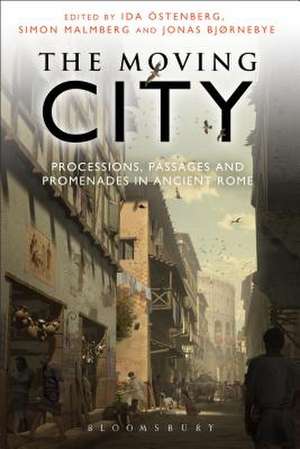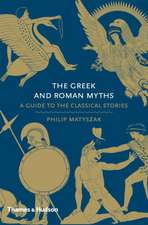The Moving City: Processions, Passages and Promenades in Ancient Rome
Editat de Ida Ostenberg, Simon Malmberg, Jonas Bjørnebyeen Limba Engleză Hardback – 26 aug 2015
| Toate formatele și edițiile | Preț | Express |
|---|---|---|
| Paperback (1) | 256.42 lei 43-57 zile | |
| Bloomsbury Publishing – 24 aug 2016 | 256.42 lei 43-57 zile | |
| Hardback (1) | 952.42 lei 43-57 zile | |
| Bloomsbury Publishing – 26 aug 2015 | 952.42 lei 43-57 zile |
Preț: 952.42 lei
Preț vechi: 1369.20 lei
-30% Nou
Puncte Express: 1429
Preț estimativ în valută:
182.30€ • 198.09$ • 153.23£
182.30€ • 198.09$ • 153.23£
Carte tipărită la comandă
Livrare economică 21 aprilie-05 mai
Preluare comenzi: 021 569.72.76
Specificații
ISBN-13: 9781472528001
ISBN-10: 147252800X
Pagini: 384
Ilustrații: 10 bw illus
Dimensiuni: 156 x 234 x 22 mm
Greutate: 0.7 kg
Editura: Bloomsbury Publishing
Colecția Bloomsbury Academic
Locul publicării:London, United Kingdom
ISBN-10: 147252800X
Pagini: 384
Ilustrații: 10 bw illus
Dimensiuni: 156 x 234 x 22 mm
Greutate: 0.7 kg
Editura: Bloomsbury Publishing
Colecția Bloomsbury Academic
Locul publicării:London, United Kingdom
Caracteristici
Explores a wide range of social movement, including commercial activities, power displays and individual strolls
Notă biografică
Ida Östenberg is Associate Professor of Classical Archaeology and Ancient History at the University of Gothenburg, Sweden.Simon Malmberg is Associate Professor of Classical Archaeology at the University of Bergen, Norway. Jonas Bjørnebye held the Stein Erik Hagen Chair in Cross Disciplinary Studies at the Norwegian Institute in Rome, University of Oslo, Norway, and is now an independent scholar.
Cuprins
IntroductionI. Elite Movement1. Power Walks: Aristocratic Escorted Movements in Republican Rome, Ida Östenberg (University of Gothenburg, Sweden)2. 'Moving Through Town': Foreign Dignitaries in Rome in the Middle and Late Republic, Richard Westall (Pontificia Università Gregoriana / The Catholic University of America, Italy)3. Livia on the Move, Lovisa Brännstedt (Lund University, Sweden)4. Fast Movement through the City: Ideals, Stereotypes and City Planning, Monica Hellström (Swedish Institute in Rome, Italy)5. Veiled Visibility: Morality, Movement and Sacred Virginity in Late Antiquity, Sissel Undheim (University of Bergen, Norway)II. Literary Movement6. Rolling Thunder: Movement, Violence and Narrative in the History of the Late Roman Republic, Isak Hammar (Lund University, Sweden)7. 'A Shouting and Bustling on All Sides (Hor. Sat. 1.9.77-8): Everyday Justice in the Streets of Republican Rome, Anthony Corbeill (University of Kansas, USA)8. Urban flux: Varro's Rome-in-progress, Diana Spencer (University of Birmingham, Great Britain)9. Augustan Literary Tours: Walking and Reading the City, Timothy M. O'Sullivan (Trinity University, USA)III. Processional Movement10. Moving In and Moving Out: Pagan ritual movements between Rome and its Suburbium, Kristine Iara (American Academy in Rome, Italy)11. Augustus' Triumphal and Triumph-like Returns, Carsten Hjort Lange (Aalborg University, Denmark)12. Rites of Passage: On Ceremonial Movements and Vicarious Memories, Gitte Lønstrup Dal Santo (Danish Institute in Rome/Copenhagen, Denmark)13. The Laetaniae Septiformes of Gregory I, S. Maria Maggiore and early Marian cult in Rome, Margaret M. Andrews (University of Pennsylvania, USA)14. Movement and the Hero: Following St. Lawrence in Late Antique Rome, Michael Mulryan (University of Kent, Great Britain)IV. Movement and Urban Form15. Towards a History of Mobility in Ancient Rome (300 BCE to 100 CE), Ray Laurence (University of Kent, Great Britain)16. 'Ships are Seen Gliding Swiftly along the Sacred Tiber': The River as an Artery of Urban Movement and Development, Simon Malmberg (University of Bergen, Norway)17. Monuments and Images of the Moving City, Anne-Marie Leander Touati (Lund University, Sweden)18. Mithraic Movement: Negotiating Topography and Space in Late Antique Rome, Jonas Bjørnebye (Norwegian Institute in Rome, Italy/Bardu, Norway)Index
Recenzii
In its fashionable focus on society's experience of space [The Moving City] is a product of its time. It is an enjoyable read, successfully presenting a picture 'of a bustling, lively society, where cityscape and movements are closely interactive and entwined'.
The range of papers and topics within this coherent volume is impressive and should interest a similarly wide range of researchers, as well as providing useful material for undergraduate classes on subjects as diverse as Augustan poetry, late Republican politics, the supply of Rome and early Christian Rome.
A well-thought out, versatile and inspiring study on "movement in the city".
Impressively show[s] the manifold possibilities and opportunities that lie in the connections between space and performance.
The monuments of ancient Rome, rooted in time and place, impress us with their calm stolidity. This rich collection of essays successfully reminds us that they were the backdrop to a city in permanent motion - from the stately processions of ambassadors and empresses, to the regular ebb and flow of traffic on the Tiber, and to the chaos of a rampaging crowd.
Particularly noteworthy are the contributions of A. Corbeill, C.H.Lange, M. Andrews and G. Lønstrup Dal Santo, each of which illuminates movements in the physical, mental and/or literary space of Rome.
The range of papers and topics within this coherent volume is impressive and should interest a similarly wide range of researchers, as well as providing useful material for undergraduate classes on subjects as diverse as Augustan poetry, late Republican politics, the supply of Rome and early Christian Rome.
A well-thought out, versatile and inspiring study on "movement in the city".
Impressively show[s] the manifold possibilities and opportunities that lie in the connections between space and performance.
The monuments of ancient Rome, rooted in time and place, impress us with their calm stolidity. This rich collection of essays successfully reminds us that they were the backdrop to a city in permanent motion - from the stately processions of ambassadors and empresses, to the regular ebb and flow of traffic on the Tiber, and to the chaos of a rampaging crowd.
Particularly noteworthy are the contributions of A. Corbeill, C.H.Lange, M. Andrews and G. Lønstrup Dal Santo, each of which illuminates movements in the physical, mental and/or literary space of Rome.















